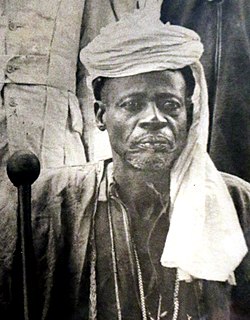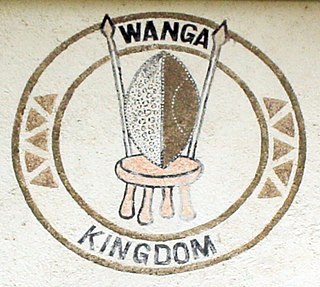Kakamega is a town in western Kenya lying about 30 km north of the Equator. It is the headquarters of Kakamega County that has a population of 1,867,579.

The Luhya comprise a number of Bantu ethnic groups native to western Kenya. They are divided into 20 culturally and linguistically related tribes.

The Bukusu people are one of the seventeen Kenyan tribes of the Luhya Bantu people of East Africa residing mainly in the counties of Bungoma and Trans Nzoia. They are closely related to other Luhya people and the Gisu of Uganda. Calling themselves BaBukusu, they are the largest tribe of the Luhya nation, making up about 34% of the Luhya population. They speak the Bukusu dialect.

After the 2013 general election, and the coming into effect of the new constitution, provinces became defunct and the country was now divided into 47 counties. Each county has its own government and therefore there is no central regional capital. Western Province became the Western region, comprising four counties: Kakamega, Bungoma, Vihiga, and Busia.
Luhya is a Bantu language of western Kenya.

The Masaba people, or Bamasaaba, are a Bantu people inhabiting the eastern Ugandan districts of Sironko, Manafwa, Bududa, Mbale,Namisindwa and Bulambuli. They are closely related to the Bukusu and Luhya of Western Kenya. They are a mainly agricultural people, farming millet, bananas and sorghum on small-holder plots. Maize became popular with the coming of Europeans in late 1890s.
Matungu is a small town in the Western Province of Kenya. It is located in the Kakamega County.
Mumias is a town in Kakamega County of Kenya. The town has an urban population of 116,358 . Mumias was the centre of the Mumias District. The town is linked by road to Kakamega, Busia (west), Bungoma (north), Butere (south). The village of Buchinga is located between Mumias and Kakamega.
Butere is a town in Kakamega County of the former Western Province of Kenya. It has an urban population of 4,725. Until 2010, the town was the capital of the former Butere/Mumias District.
Nyamninia is a village in the Gem Location, Yala division of Siaya County, Kenya. Situated approximately 30 miles from Kisumu city, Nyamninia is home to the 100 kilowatts medium wave radio transmitters set up by Voice of Kenya (VoK); now renamed Kenya Broadcastic Corporation (KBC). It was the birthplace of the legendary Gem clan chief, Odera Kang'o who started a rice plantation scheme in the area about one hundred years ago. The Gem chief was responsible for construction the numerous schools in the region before his enforced exile in 1915, to Kampala, Uganda by the British colonialists.

The Maragoli, or Logoli (Ava-Logooli), are now the second-largest ethnic group of the 6 million-strong Luhya nation in Kenya, numbering around 2.1 million, or 15% of the Luhya people according to the last Kenyan census. Their language is called Logoli, Lulogooli, Ululogooli, or Maragoli. The name Maragoli probably emerged later on after interaction of the people with missionaries of the Quaker Church.
Burundu is a rural village in Kakamega County of the former Western Province in Kenya.

The Tachoni are Kalenjin who were assimilated by the Luhya people of western Kenya, sharing the land with the Bukusu tribe. They live mainly in Webuye, Chetambe Hills, Ndivisi Matete sub-county and Lugari sub-county in Kakamega County. Most Tachoni clans living in Bungoma speak the ' Olutachoni dialect of the Luhya language, and they are subsequently often mistaken as Bukusus. They spread to Trans-Nzoia County especially around Kitale, and to Uasin Gishu County near Turbo, Eldoret. Among the Tachoni clans are Abakobolo, Abamuongo, Abamarakalu, Abangachi, Abasang'alo, Abasamo, Abayumbu, Abamuchembi, Abachambai, Abacharia, Abakabini, Abamakhuli, Abasioya, Abaabichu, Abamachina, Abamutama, Abakafusi, Abasonge, Abasaniaka, Abaabiya, Abakubwayi, Abamweya, Abachimuluku. Note that the morpheme 'aba' means 'people'. The Abakhusia/abasamo of Kabras are also Tachonis who speak Kikabras.

Tiriki is one of sixteen clans and dialects of the Abaluyia People of Western Kenya. The word Tiriki is also used to refer to their Geographical Location in Hamisi Division, Vihiga County, in the Western province of Kenya. Hamisi Constituency now Hamisi Sub County is one of the longest in Kenya stretching from kiboswa(Ny'angori) to Shiru which borders Kapsabet and Musunji which borders Kakamega Forest.

The Khayo is a sub tribe of the Luhya people of Kenya. They reside in Busia County, by the Kenya-Uganda border. Their Luhya neighbors are the Samia, Marachi, Wanga and Bukusu. The Bakhayo border the Bukusu on the East, the Republic of Uganda and Samias on the West, the Marachi on the South and the Wanga on the South East. On their north, they are bordered by the Iteso, a non-Luhya Nilotic people of Kenya.

The Marama, also known as Abamarama, are a Luhya tribe occupying Marama Location in Kakamega District of the western province of Kenya. The town of Butere is located in west Marama and is a significant trading centre in Kakamega. They are said to have assimilated the Abashikunga sub tribe.

Nabongo Mumia Shiundu was a prince who became 17th King of the Wanga Kingdom, a pre-colonial kingdom in Kenya prominent for being a centralised, highly organised kingdom and the most advanced form of government in terms of politics, economy and military in pre-colonial Kenya. He later became paramount chief of an expansive region of Kenya at the beginning of British imposition of colonial rule in East Africa.

The Wanga kingdom is a Bantu kingdom within Kenya, consisting of the Wanga (Abawanga) tribe of the Luhya people (Abaluyia). At its peak the kingdom covered an expansive area from Jinja in west to Naivasha in the East African Rift. The Wanga kingdom was a significant African empire and the most organized structure of government in pre-colonial Kenya politically, economically, and militarily.

The Nabongo Cultural Centre and Shrine is a shrine and cultural centre dedicated to the Wanga Kingdom of the Luhya people in Kenya. The shrine contains the tombs of Wanga kings or Nabongo are buried, including the founder of Mumias, Nabongo Mumia. Locally known as Eshiembekho, the shrine is managed by the Luhya Council of Elders.
Nabongo Wanga was the founding father of the today's Wanga subtribe of the Luhya tribe of Kenya. He was born around 1050 A.D. His reign was between 1100 A.D. to his death around 1140 A.D.





